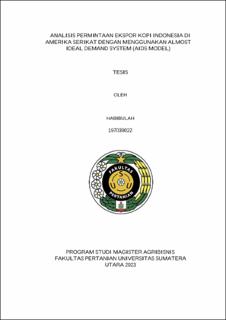| dc.description.abstract | Indonesia is the fourth largest coffee producing country in the world after Brazil, Vietnam and Colombia. Of the total production, around 67% of the coffee is exported while the rest (33%) is used to meet domestic demand. The level of domestic coffee consumption based on the results of the 1989 LPEM UI survey was 500 grams/capita/year. Coffee entrepreneurs estimate that coffee consumption in Indonesia has reached 800 grams/capita/year. Likewise, within 20 years the increase in coffee consumption has reached 300 grams/capita/year. (AEKI 2022). competition research on Indonesian coffee in the United States market by using the Almost Ideal Demand System (AIDS) method. The use of the AIDS model is used to analyze the position and level of competition between coffee exporting countries (Indonesia, Vietnam, and Brazil and Colombia) from each export destination country, namely the United States. the estimation results on the AIDS model of Indonesian coffee in the United States market get an R-Square value of 0.4136 percent. Vietnam in the United States market obtained an R-Square value of -0.216 . Brazil in the United States market obtained an R-Square value of 0.44 percent. Columbia in the United States market obtained an R-Square value of 0.4488 percent. Coffee from Indonesia competes with coffee from Vietnam, Brazil and Columbia. The cross-price elasticity obtained between the price elasticity of Indonesia-Vietnam coffee is positive at 0.9443, and the price elasticity value of Indonesia-Brazil coffee is 0.0330, the price elasticity value for Indonesia-Columbia coffee is 0.5854. The expenditure elasticity values obtained by Indonesian coffee were 0.4479, Vietnam coffee were 1.7403, the expenditure elasticity values for Brazil and Columbia coffee were 1.0155 and 0.9042. in the United States Market. | en_US |


